Oculus reparo
Around 285 million people worldwide are visually impaired (WHO website). Of these, 246 million have low vision while the rest are blind. What’s more, 90 percent of them populate developing countries, and are challenged by the way society treats them. In a nutshell, there’s not much they can do; not many places cater to their specific needs, not many ‘normal’ people who empathize.
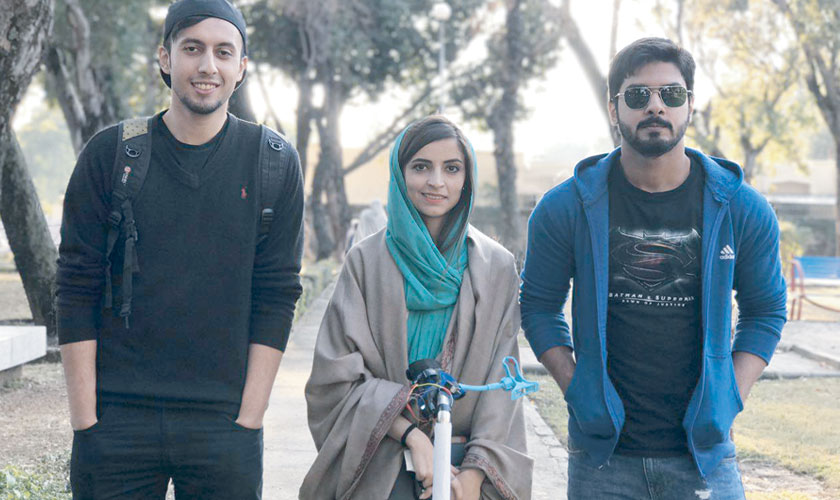
Maybe if life did come with a rewind button, those impaired visually due to preventable/curable causes could have managed differently and hence steered clear of this struggle. Wishful thinking? Plus, it would leave out those who are deprived of vision since birth and then there’s the age factor. But hey, it’s the information age, technology rules and nothing is impossible anymore.
Three students from COMSATS University, Islamabad – Faizan Shabbir, Javeria Rasheed and Hashim Naveed – have come up with Optasia-Navigation system for the visually challenged people. Why? One of their friends, Abdullah Gul Shafi, had a brother who was partially blind. The fact that he had to stop studying and eventually leave school because his vision deteriorated with time inspired the trio for this project. At that time, the idea was quite vague and required a lot of attention and modification to be deemed presentable.
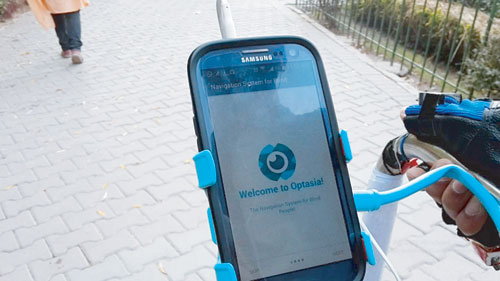
Developing the app
Praise should be given to those who deserve it and the way these geniuses put their heart and soul into this project, selflessly, intent only on doing something for people who are in need of assistance, should be applauded.
Hashim: [The app] could at least [help] these people to travel/walk easily. If they are able to move from one place to another conveniently, they can go and attend lessons or listen to the lectures and so on.
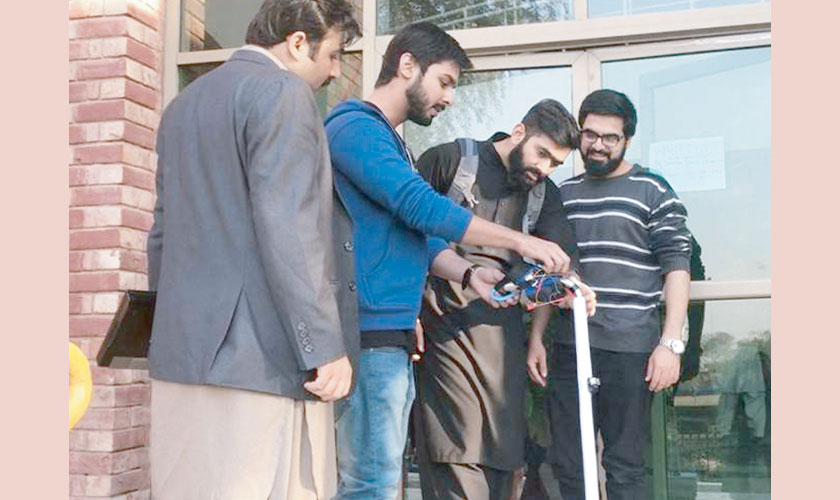
Faizan: We decided to start with our campus. We designed a product which could provide assistance to partially blind or blind people in order that they may navigate from one department to the next easily.
Specific features
Faizan: We have three modules for Optasia (Greek term for ‘vision’): navigation, object detection, object recognition.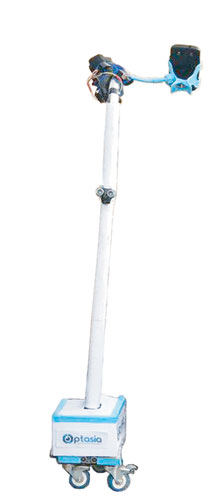
Hashim: We are improving this application. We can also add more objects that could be detected. Right now, we have added the following objects which could be detected: COMSATS logo, pot/vase, face, stop sign. We are currently working on including recognition of Pakistani currency to the list.
This can be further scaled up. For instance, the app only has our campus’s map and with time it can be used outside its boundary as well.
In customer’s hands
Smooth navigation in Pakistan is tricky, to say the least. How did they ensure it? Let’s have a look.
Javeria: We have developed Optasia by using Google Maps. The problem with Google Map is that it has few restrictions and limitations. This app is best for organization in which we have a boundary and radius.
And if we want to scale up, we have the option of street view. (Street view gives you an in-depth analysis of streets.) Secondly, with the help of image processing, we can improve the app to the extent that one is able to detect red lights and zebra crossings, too. If the visually-impaired lose his or her track on zebra crossing, for instance, the app would produce vibrations. It’s a vast field; this is just the beginning, a prototype if you will, and definitely, it can be improved – and, we intend to do that.
The best way forward
A desire to improve lives must also factor in other things. In offering a ‘complete package’, how does Optasia gets the better of other similar apps in the market?
Javeria: Upon researching, we found the stick has an alternative, Ultracane, a UK-based product. It costs around one lac rupees in Pakistan. It is quite efficient – blind people can even run while using it. But it has 5m range and is not shipped easily to Pakistan! Another drawback is it only detects objects.
There is another mobility aid, iVision, a ring to be used in library. The wearer would pinpoint a book; it takes the picture of that book and sends it to the server, which then identifies the book for the person.
The stick that we have designed would tell the direction as well. For example, it tells you whether the object is coming from the left side or the right side or if it is in front or lower front. Further, we have set a 100cm range so when the object comes in that range, it alerts the user through vibrations.
Hashim: We have seen many products, but we have not come across any product that offers everything – navigation, object identification, vibration. So, we have a huge market for Optasia in Pakistan. If we offer it at cheap rates, then this could go really well.
Beating the odds
Rejections are off-putting. Criticism does not always polish a rough diamond into a gemstone; being risk-averse may damage any chance of success. Did they face such cricumstances? Definitely! How did they overcome?
Faizan: There’s this one incident that I remember. The day we were giving our presentation, we were asked why the app is not available in Urdu and what if the person did not know English, what use would this app be to him/her.
Javeria: Everyone was always encouraging.
Faizan: However, when we talk with respect to the difficulties faced while working on our project, then yes there were some limitations which forced us to backtrack and start again. Javeria mentioned the OpenStreetMap (OSM) earlier; initially, we planned to use it for our app but we had no documentation at that time for its Android development. We had to shift to Google Maps. Since it was very crucial to provide voice guidance to blind user, and since Google says it’s illegal to provide voice direction while using their product, we invested a good number of days (one-and-a-half to two months) doing our research on how to tackle it. We decided that for the time being we’d restrict the boundary to COMSATS University only and code the respective directions ourselves.
Javeria: Honestly, we were going against the tide since Day One. In majority of the cases, the supervisor gives their ideas and insists that students take it up in the project. When we went and discussed what we wanted to work on, it was approved. At that point, we knew nothing, whether it was about android development or how to work on maps or which hardware to choose or what is image processing. We had six months to study all these fields as well as to implement it. I kind of thought we wouldn’t be able to make it, that perhaps one of the modules will remain incomplete. It was a surprise for all of us that we weren’t stuck for too long at any one stage. The process finished smoothly enough.
One thing I have learned from this experience is never give up. I had no idea of the sort of work Faizan or Hashim were doing; they were clueless about my part. But whenever any of us felt hopeless, the other two ensured they were there to basically build the team morale. So, never give up and be positive about what you are doing. If you are passionate about something, you can definitely do it.
Faizan: Remember, hard work always pays off. I struggled with image processing. There are only a handful of people who know it and so I literally had no one to help me figure out stuff I couldn’t understand. I would just attempt different methods every day – bas pangay le raha tha us say – to make it work just once. Then one fine day it did. It took me around two or three months to work out the correct combination, and finally it worked. It felt good.
In teamwork there is strength
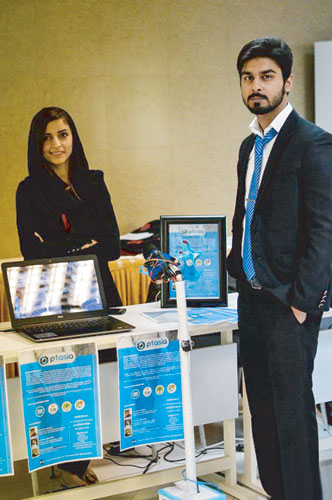 Javeria: I think it’s based on friendship. From the first semester, we’ve been doing assignments together. We never faced any difficulty in completing the projects. I couldn’t work for a whole month when my mother got injured. But it didn’t freak me out as much as it would probably have had I been part of another group, without my friends, who would have assumed the worst and accused me of not working. Instead, both Hashim and Faizan continued with work on their end, without hassling me. I think the things which keep the team together are understanding and friendship. It was really helpful that we knew the strengths and weaknesses of each member and divided the work accordingly.
Javeria: I think it’s based on friendship. From the first semester, we’ve been doing assignments together. We never faced any difficulty in completing the projects. I couldn’t work for a whole month when my mother got injured. But it didn’t freak me out as much as it would probably have had I been part of another group, without my friends, who would have assumed the worst and accused me of not working. Instead, both Hashim and Faizan continued with work on their end, without hassling me. I think the things which keep the team together are understanding and friendship. It was really helpful that we knew the strengths and weaknesses of each member and divided the work accordingly.
Faizan: On top of that, we are not the procrastinating type so we never faced issues students usually face during group projects.
An experience worth remembering
No matter how much we think we hate our universities, a specific subject or task, we always miss it when we leave. Even insignificant details have the power to become our fondest memories.
Faizan: Once the project was complete, we had to prepare a video, including a proper demo of our app, to show to the committee during class presentation. The ‘memorable’ part is that I was the one acting in that video and both Javeria and Hashim made me walk through the entire campus in that style while recording it.
Javeria: The video went viral on social media and people actually thought we had a blind person in our group!
Also, Hashim usually picks up Faizan on his way to the university. I have my own transport and I am usually the first one to reach. Most of the times when I ask him about their whereabouts, his reply is the same: yaar ek ghantay se Faizi kay ghar kay bahar hoon; meray khayal mein naha raha hai aur phir makeup kar ke ayega. He takes a lot of time to get ready! (Laughing)
Advice to app geeks
There are things you learn the hard way, things no one teaches or preps you in advance about. Are there any insights on resources they can recommend to someone who wishes to develop an app in future?
Hashim: Apply to as many incubations as possible! It’s where you get all the expertise, resources and funds for you work. The professionals will help you improve your app or whatever you are doing.
Javeria: The best way is to read documentations. Like when we started, I didn’t know a word about app development. I am more of a practical person and I would recommend the same to students that don’t just rely on theoretical work only, but also implement/apply and be practical. Both are equally important.
World Sight Day is an annual day of awareness held on the second Thursday of October, to focus global attention on blindness and vision impairment.
Faizan
Age: 23
Hometown: Sialkot
Hobbies: Gym, gaming, coding
Javeria
Age: 23
Hometown: Mianwali
Hobbies: Graphic designing, event management, watching movies, and not studying a lot.
Hashim
Age: 22
Hometown: Rawalpindi
Hobbies: Interested in sports, travelling, anything which is new; love to try different things